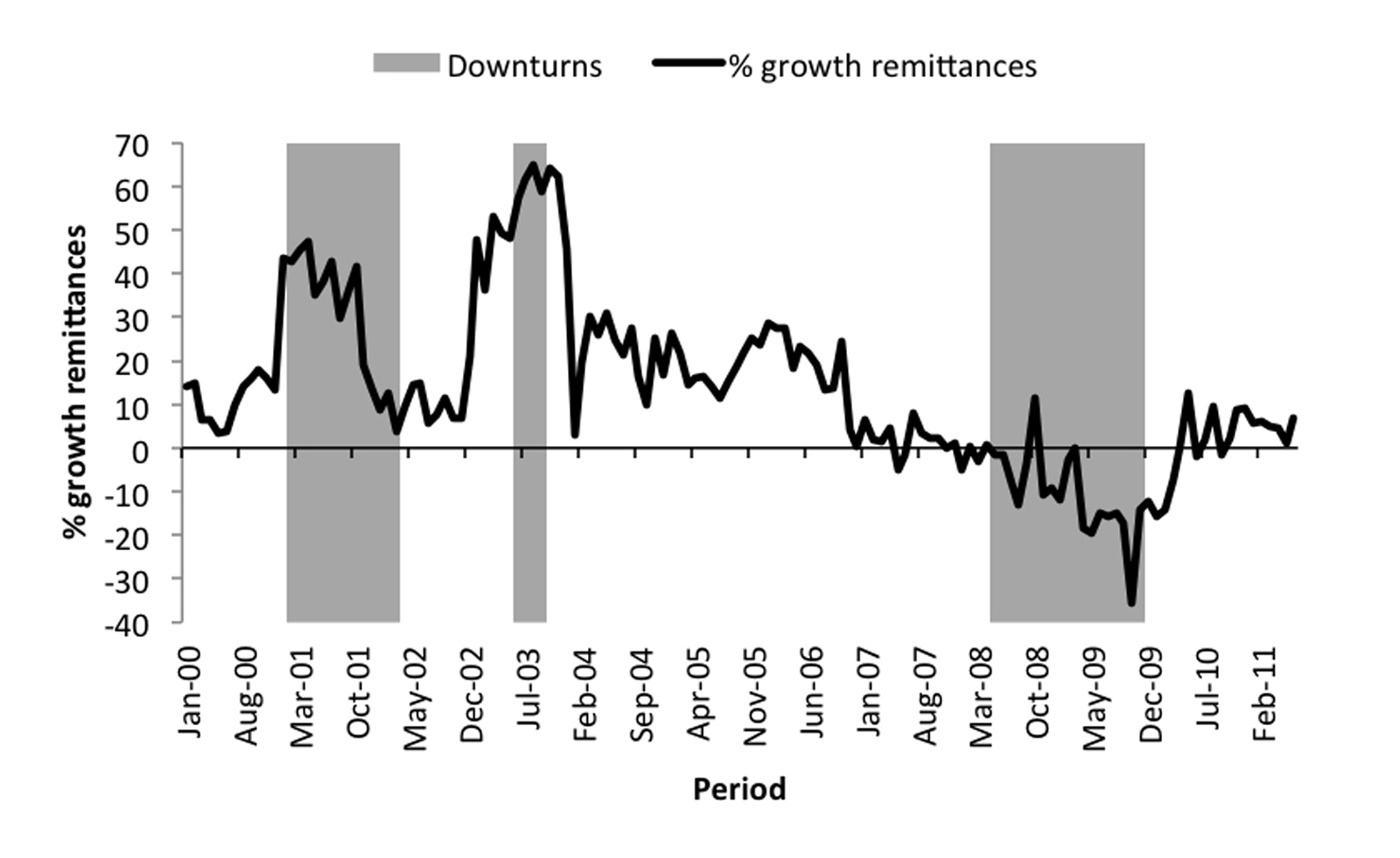 International development organisations and academic researchers often suggest that remittances could have a beneficial impact on receiving countries. One of the key areas in which remittances have the potential to be particularly useful relates to business cycle fluctuations. The term ‘business cycle’ refers to economy-wide fluctuations in production involving shifts over time between periods of relatively rapid expansion and periods of contraction. The potential usefulness of remittances is straightforward: If remittances are counter-cyclical and increase significantly when the home economy is in a downturn, these flows may then work as macroeconomic stabilisers that boost the recipient economy during downturns and cool off the economy during upturns. That is, remittances can have a ‘smoothing’ effect on the business cycle of receiving countries.
International development organisations and academic researchers often suggest that remittances could have a beneficial impact on receiving countries. One of the key areas in which remittances have the potential to be particularly useful relates to business cycle fluctuations. The term ‘business cycle’ refers to economy-wide fluctuations in production involving shifts over time between periods of relatively rapid expansion and periods of contraction. The potential usefulness of remittances is straightforward: If remittances are counter-cyclical and increase significantly when the home economy is in a downturn, these flows may then work as macroeconomic stabilisers that boost the recipient economy during downturns and cool off the economy during upturns. That is, remittances can have a ‘smoothing’ effect on the business cycle of receiving countries.
International organizations have actually promoted this potential effect of remittances. Here is a statement from the World Bank in 2006:
“Remittances may move countercyclically relative to the economic cycle of the recipient country. Remittances may rise when the recipient economy suffers a downturn in activity or macroeconomic shocks due to financial crisis, natural disaster, or political conflict, because migrants may send more funds during hard times to help their families and friends. Remittances may thus smooth consumption and contribute to the stability of recipient economies.”
The implications of this smoothing-out effect are major. It can be argued then that governments should not try to control remittances in the name of national development, but should rather let migrants remit without restraint. In other words, the government should refrain from taking control over remittance flows in order to channel them toward more productive uses. The free flow of remittances should allow these transfers to adjust to cyclical fluctuations in receiving countries in a manner that has positive implications for economic stability.
However, there is also always the other possibility: remittances could be pro-cyclical, meaning that the flows decrease after downturns in the home economy. In this case, receiving countries may have to deal with an additional impact (i.e. the amplification effect) of these downturns.
Given the importance of counter-cyclical vs pro-cyclical trends for policies towards remittances, a large literature which tests these possibilities has developed during the last decade (including some of my own work).
In a new paper which was just published in the Journal of Ethnic and Migration Studies (JEMS) and which is co-authored with Isabel Ruiz, we argue that the cyclical nature of remittances is unlikely to be stable over time. These flows may be counter-cyclical at some point and pro-cyclical at others. Therefore, the potential of remittances to smooth out cyclical fluctuations in output is highly questionable.
Take for instance the figure below which plots the growth rate of remittances to Mexico, along with shaded areas that indicate downturns in the Mexican economy. There are noticeable increases in the growth rate of remittances during the 2001 and 2003 downturns. This relationship does not hold for the 2008-2009 downturn. In fact, there is a significant decrease in the growth rate for late 2009. There is an obvious explanation for this fact. The slowdown in the US economy during 2008 and 2009 affected strongly those sectors that employed large numbers of Mexicans, such as the construction and service sectors. The adverse economic conditions of many Mexican migrants may have discouraged them from increasing remittances to compensate their families affected by the poor economic conditions in Mexico.
More sophisticated analysis in the JEMS article supports the same conclusion. Remittances are not always countercyclical flows that come to the rescue in times of economic distress in the home country. Instead of simply analysing the cyclical nature of remittances (again and again and all over again), future research should explore the reasons for the changes in the cyclical nature of remittances over time. Meanwhile, remittance-receiving countries should be wary about creating policies based on unstable relationships.
References
- Ruiz, I. and Vargas-Silva, C. ‘Remittances and the Business Cycle: A Reliable Relationship?, Journal of Ethnic and Migration Studies , 40(3): 456–474.
- Vargas-Silva, C. (2008) ‘Are remittances manna from heaven? A look at the business cycle properties of remittances’, North American Journal of Economics and Finance, 19(3): 290–303.
- World Bank (2006) Global Economic Prospects: Economic Implications of Remittances and Migration. Washington DC: World Bank.
